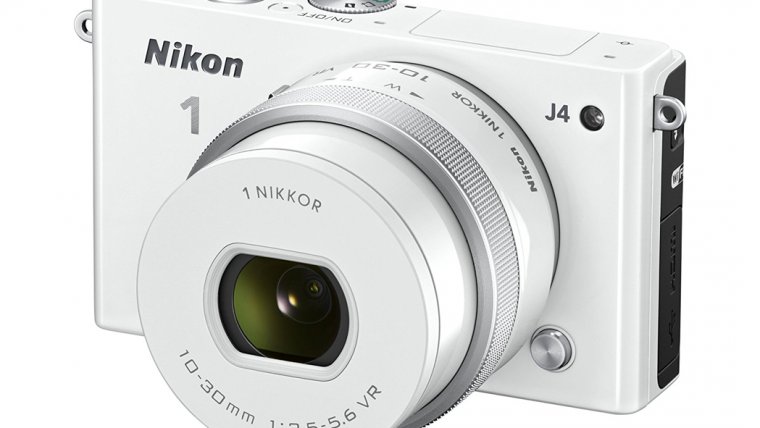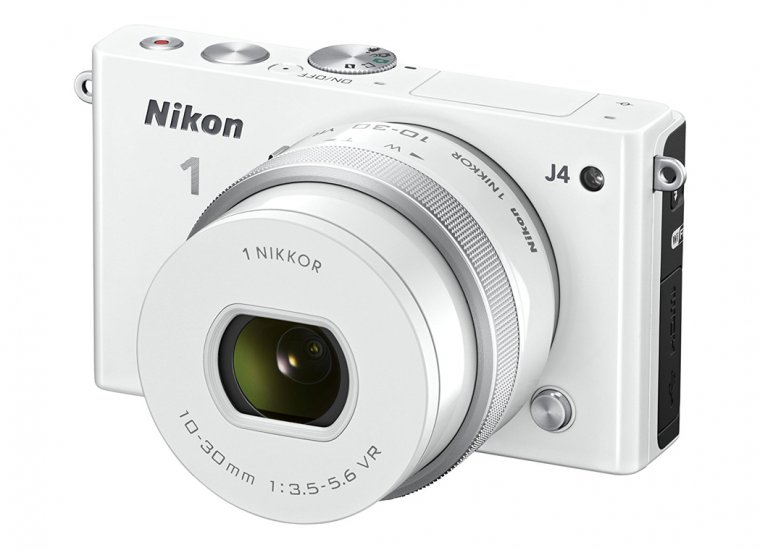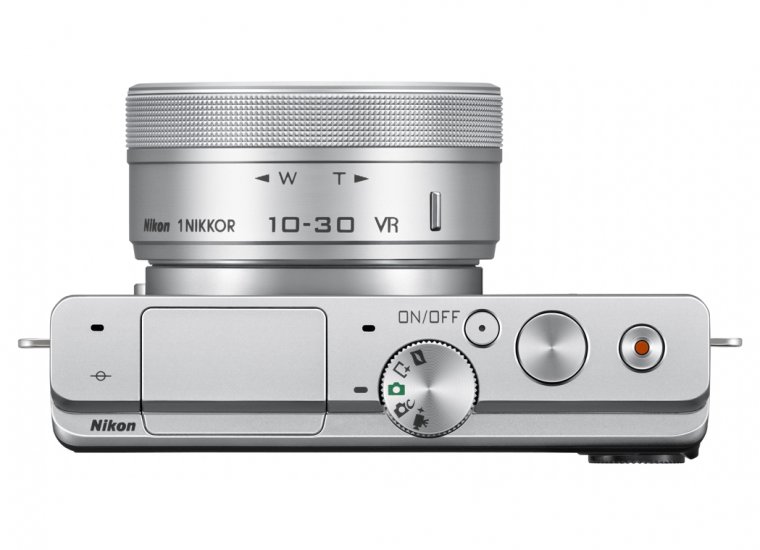
The rise of popularity of mirrorless cameras also meant that some other types of cameras had to fall in the second plan. That’s exactly what happened to compact cameras. The reason behind this that the mirrorless cameras easily overshadowed many compact cameras due to them becoming more accessible to large number people and also because of the holy trio of main selling points: compactness, the ability to change lenses and also them sporting large sensors that could previously only be found on DSLRs. This began to change in favor of compact cameras with the introduction of 1-inch sensors because of them being far more capable that the regular 1/2.3-inch sensors found in most cameras.
This is where Nikon came in with and decided to take advantage of that trend while also doing something different from other manufacturers. The Nikon 1 J4 is one of the few cameras that came to be as a result of their vision. What sets this camera apart from other compact cameras bearing the sensor of the same size is the ability to change lenses, something that is still rare to find on the camera market. Let’s see how well they implemented this idea and is it really the differentiating factor that Nikon was looking for to be considered as one of the best Nikon cameras.
Table of Contents
The first thing that immediately impresses about the Nikon 1 J4 when you hold it in your hands is its build quality and its attractive design like the Samsung NX Mini which is so cute. The brushed metal feels smooth to the touch and there’s also that nice feeling when you haven’t used the camera for a while and the metal is completely cold. Nikon has really outdone themselves in terms of build quality and we would never expect something built to such a high standard at this price point. Another interesting thing about the J4 is the choice of different colors that come with it. In addition to your standard black color you can also get it in white, silver or even orange color. To make it stand out even more, the back of the camera one each color variant remains completely black. What also stands out on the Nikon 1 J4 is its rather modest control scheme.

There aren’t really many manual controls to be found and it seems that Nikon’s philosophy behind it was to keep it as simple and clutter-free as humanly possible. We are little worried that this could negatively affect the usability of the camera, but we have to dig a little deeper before we can draw a final conclusion. So, let’s take a look. The front of the camera only holds the lens mount, lens release button and the focus assist light. The left side of the camera holds the button that pops up the flash unit as well as the HDMI and USB ports. The right side holds no buttons and ports and is completely clean. The top of the camera reveals the stereo microphones, the flash unit that is neatly flushed with the body, main mode dial as well as shutter, power and video recording buttons. Finally, it’s time to look at the back of the camera. Here you’ll find the 3-inch touchscreen and the small arrangement of buttons consisting of Playback, Menu and Delete buttons as well as the navigation wheel that also doubles as a four-way joystick which serves a quick way to activate the timer, flash control, exposure compensation as well as focusing modes. As there’s really not much going on here in terms of sheer amount of controls, the user interfaces itself will be the deciding factor when it comes to judging the J4’s usability and ease of use. But, before we dwell into this, while we are still on the hardware side of things, we thought we should mention the kind of lenses you can get for the Nikon 1 system.
Since this is an interchangeable lens camera, after all, it’s important to know how much of flexibility you’ll gain with this camera with different kinds of lenses. Since it has a 1-inch sensor, the crop factor sits around 2.72, so to make life easier for you, we will also put the actual focal length you can expect besides the one that’s written on the lens itself. Judging by the Nikon’s website, there are 13 lenses available for purchase as of now. The widest lens you can get is the 6.7 – 13 mm one, which equals to about 18 – 35 mm, a great range for a camera with a 1-inch sensor. Your standard zoom and a kit lens are the 10 – 30 mm (27 – 81 mm) and you can also get the 10 – 100 mm lens (27 – 272 mm) if you want more range. The longest lens in the lineup is the 70 – 300mm which results in a very impressive range of 190 – 816 mm. All of these lenses have VR or optical image stabilization. Lastly, if you are more interested in primes you can get the 18.5 mm f1.8 (50 mm) or the 32mm f1.2 (87 mm) lens. There are also variants of 10 – 30 mm and 10 -100 mm with PD or Power Drive Zoom which promises to give you smoother zoom than the regular variants. While this doesn’t sound like a very impressive variety of lenses for an ILC, it’s still very respectable when you compare the Nikon 1 J4 with other cameras sporting a 1-inch sensor. You really can’t get this kind of flexibility and zoom range on any other lineup of compact cameras unless you want to move to something much bigger and less compact like for example a bridge style camera.

Before we end this section of the review, we still have to touch on two more things: user interface and Wi-Fi. We have to admit that we are pleased with how Nikon optimized the interface for touchscreen use and how easy it is to navigate. Everything is color coded and no setting or feature feels out of place, the icons and the text are big enough and easy to read and every part of the menus no matter if it’s the part where you have to scroll through something or adjust a setting blends perfectly and allows for very fast and precise usage. We would still like to have more physical controls for those occasions where you can’t comfortably operate a touchscreen like cold, dirty or wet weather, but since this is a camera primarily targeted at casual users and isn’t protected from the elements, we don’t believe that many people would want to use the J4 in those conditions anyways.
In regards to Wi-Fi functionality, the J4 offers everything you would expect from a camera with Wi-Fi built in. You can back up your photos, post them directly to social networks or edit them beforehand and even remotely control the camera with the help of Nikon’s Wireless Mobile Utility application which is available either for Android or iOS devices. We are very surprised to see remote control functionality on a camera of this caliber since many manufacturers decide to leave it out of their cameras for some reason. We weren’t expecting a lot from Nikon 1 J4 in terms of its usability when we first laid our eyes on the camera, but after examining it more closely we are actually quite happy with what it has to offer. It’s a simplistic camera which relies heavily on a touchscreen for most of its controls and it isn’t a bad thing in the case of the J4. It’s executed so well and really caters to those users which are used to taking photos with their smartphones and want to upgrade to something much more flexible, but without the steep learning curve like on some other cameras. We are also impressed by the available lenses, no matter how small in numbers they actually are.
The AF system in the J4 is a pretty unique one for a camera of its type. It’s a hybrid autofocus system which consists of 171 contrast detect based and 105 phase detect based focus points. This means that the camera is well equipped no matter the conditions you are shooting in and that you should end up with reliable performance most of the time. We are happy to report that the J4 performs admirably in this regard, no matter if you are shooting moving subjects or in very low light. In most of the situations, the camera will prioritize the use of phase detect points as they are a lot faster than contrast-detect one which it tends to use only when light levels drop and it’s harder to achieve critical focus. The system works very well without any additional setup required from the user, but you do get different focus modes if you need them and these are the Single Point AF, Subject Tracking and Auto Area modes. You can also focus manually despite the lack of focus ring on Nikon 1 lenses and you can do so with the help of navigation wheel on the back of the camera. There’s also no focus peaking and you only get the traditional magnified view and distance scale to help you with focusing.

Thanks to the very powerful Expeed 4 the general performance on the Nikon 1 J4 is simply excellent. There are no stutters or hiccups to be found no matter what your business is with the camera. It will always perform consistently well 100% of the time and there’s nothing more you could ask for out of a camera. In regards to burst rate, you can either choose between 20 fps mode with continuous AF enabled or 60 fps mode with focus fixed on the first shot. This is a really impressive performance for such a small camera even if the buffer size isn’t the biggest we’ve seen. Still, the J4 can easily serve as a backup sports camera for those days when you can’t be bothered with carrying your main camera and all the gear that comes with it and you just want something compact and still fast enough to do the job. Battery life is also satisfactory when you take into account the J4’s size and is rated to about 300 shots per charge. While all of us like to criticize products for their flaws and fin some pleasure in uncovering them, we really couldn’t find any in regards to J4’s performance. It’s a great all-around performer and that’s it.
While the J4 doesn’t seem to be a camera you would primarily buy to shoot videos with, it does have some neat tricks up its sleeve. To get the traditional stuff out of the way, you can record footage up to 1080p resolution at 60 fps or 30 fps and you can also shoot at 120 fps when you drop to 720p resolution. There’s also stereo sound recording on board together with full manual exposure control. You also get very useful and well-implemented autofocus in the video due to that advanced hybrid AF system, which is something rarely seen on a camera in this price range. The quality of recorded footage isn’t the best we’ve seen, but it’s definitely above average and very usable in all conditions but those that require high ISO values, which are a challenge for this little camera. Now, one of the unique features of this camera is the ability to shoot slow motion videos at 400 and even 1200 fps, but albeit with reduced resolution. If you can live with some compromise in video quality, you can have a lot of fun and make some unique looking videos.
The Nikon 1 J4 performs quite well when it comes to taking stills. Of course, the amount of detail you can get out of it will depend on the lens being used, but even if you decide to only stick with included 10 – 30 mm kit lens you can still end up with very decent looking photos, especially if you stop down the aperture. Dynamic range and contrast levels are ok and the colors are balanced and never oversaturated. Noise performance is also quite good and you will get clean images up to an ISO of 800 and very usable shots up until 3200.

Photo courtesy of Daishi Nasure
The last two ISO settings (6400 and 12800) are only there if you really need to take the shot despite the noticeable drop in image quality. If you decide you want to play around a little with different effects or picture styles, you also get plenty of those at your disposal. Some of them are HDR, Selective Color, Miniature Effect, Toy Camera, Landscape, Vivid, Monochrome and so on. So, you really get a lot of performance in a small package when it comes to Nikon 1 J4.
We are really impressed with what Nikon has done with the J4. It’s really a unique blend of a compact camera with a sensor of above average size and a traditional mirrorless interchangeable lens camera. We didn’t know if this will turn out to work well or will it be a flop, but in actually ended up to be an interesting concept that has no real flaws to it. You get all the compactness and ease of use of your traditional compact camera wrapped in a premium metal body and also all of the flexibility brought by the ability to change lenses instead of relying on a fixed one. In this regard, the J4 offers an unbeatable range of different focal lengths and types of lenses that no other compact camera with a 1-inch sensor can compete with. It does all of that without any noticeable loss in image quality, no matter if we are talking shooting videos or taking stills. Add to that one of the best AF systems we’ve ever seen on a compact camera and the performance worthy of a professional camera in regards to both the general speed of use and taking bursts of images and you’ve got a very compelling package worthy of checking out. It’s always interesting to see new ideas being brought to life, but it’s even better when they end up being more than gimmicks and actually work out. This is surely the case with the Nikon 1 J4. It’s a camera that rose from the idea that could have easily given us a product with no real impact on the camera market, but thanks to Nikon’s expertise we were given a truly unique product that will surely found its audience no matter what kind of photographer you really are.
We didn’t know if this will turn out to work well or will it be a flop, but in actually ended up to be an interesting concept that has no real flaws to it. You get all the compactness and ease of use of your traditional compact camera wrapped in a premium metal body and also all of the flexibility brought by the ability to change lenses instead of relying on a fixed one. In this regard, the J4 offers an unbeatable range of different focal lengths and types of lenses that no other compact camera with a 1-inch sensor can compete with. It does all of that without any noticeable loss in image quality, no matter if we are talking shooting videos or taking stills. Add to that one of the best AF systems we’ve ever seen on a compact camera and the performance worthy of a professional camera in regards to both the general speed of use and taking bursts of images and you’ve got a very compelling package worthy of checking out.
It’s always interesting to see new ideas being brought to life, but it’s even better when they end up being more than gimmicks and actually work out. This is surely the case with the Nikon 1 J4. It’s a camera that rose from the idea that could have easily given us a product with no real impact on the camera market, but thanks to Nikon’s expertise we were given a truly unique product that will surely found its audience no matter what kind of photographer you really are.
Comments (0)
There are no comments yet.